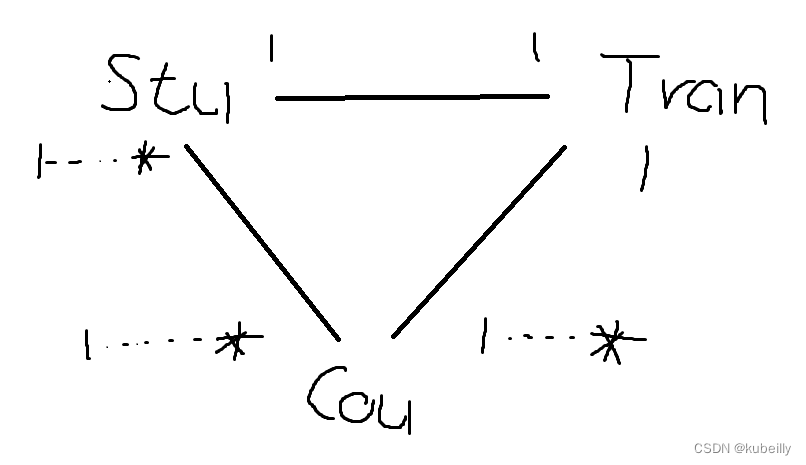本文主要是介绍Java笔记(第十节 and 第十一节),希望对大家解决编程问题提供一定的参考价值,需要的开发者们随着小编来一起学习吧!
本节内容:1:Associations 2:Multiplicity 3:实践
1:Associations:
定义:The formal name for a structural relationship that exists between classes is an association.
关联关系
关联(Association)关系是对象之间的一种引用关系,用于表示一类对象与另一类对象之间的联系,如老师和学生、师傅和徒弟、丈夫和妻子等。关联关系是类与类之间最常用的一种关系,分为一般关联关系、聚合关系和组合关系。我们先介绍一般关联。
关联可以是双向的,也可以是单向的。在 UML 类图中,双向的关联可以用带两个箭头或者没有箭头的实线来表示,单向的关联用带一个箭头的实线来表示,箭头从使用类指向被关联的类。也可以在关联线的两端标注角色名,代表两种不同的角色。
下图所示是老师和学生的关系图,每个老师可以教多个学生,每个学生也可向多个老师学,他们是双向关联。

2:Multiplicity 多重性
For a given association type X between classes A and B, the term multiplicity refers to the number of objects of type A that may be associated with a given instance of type B.
For example, a Student attends multiple Courses, but a Student has only one Professor in the role of advisor.
There are three basic “flavors” of multiplicity:
one-to-one
one-to-many
many-to-many
类图载入 -->自动生成代码window --> perspective -->open perspective -->plug in(插件)
3:下面我将会从一对一,多个一对一,一对多带你刨析内部逻辑。

小tip: 可以generate getters and setters 自动生成get和set函数
1对1:
为了可读性,我会将代码放到一个java文件中,实际应该将不同类放入不同java文件中 .
import java.util.*;
public class Main
{public static void main(String[] args){Transcript tran = new Transcript();//创建对象Stu stu = new Stu();stu.setTran(tran);tran.setStu(stu);tran.print();//输出成绩stu.study();//学习一次tran.print();}
}
class Transcript
{private String ID;int score;private Stu student;//成绩单关联学生,且只有一位public void setStu(Stu student){this.student = student;}public Stu getStu()//为什么是Stu? 将Stu理解为一种数据类型,返回值也为该数据类型即Stu{return student;}void print()//输出该成绩单所对应的学生的成绩{System.out.println(this.score);}
}
class Stu
{private String name;private Transcript tran;//学生关联成绩单,且只有一个public void setTran(Transcript tran){this.tran = tran;}public Transcript getTran(){return tran;}void study()//学生学习{tran.score++;}}
//为什么不new?输出: 0
1
为什么在类内进行关联时创建对象不需要new?
private Stu student;回归到根本,是要在主函数使用关联,然而如果在这new() ,同时在主函数new() ,在主函数中就是两段不同的内存。
也可以这么理解(个人理解):将这种关联看成是一个属性而不是创建一个新的对象,相当于Transcript有一个属性是Student。
多个一对一(添加一个course)
只需要添加一个Cou类,其他类中添加get()和set()函数,主函数中做相似改动即可.
此处将score放入Course(Cou)类中
import java.util.*;
public class Main
{public static void main(String[] args){Transcript tran = new Transcript();//创建对象Stu stu = new Stu();Cou cou = new Cou();stu.setTran(tran);//传入成绩单和课程stu.setCou(cou);tran.setStu(stu);tran.setCou(cou);cou.setStu(stu);cou.setTran(tran);cou.print();//输出成绩stu.study();//学习一次cou.print();}
}
class Transcript
{private String ID;private Stu student;//成绩单关联学生,且只有一位private Cou cou;public void setStu(Stu student){this.student = student;}public Stu getStu()//为什么是Stu? 将Stu理解为一种数据类型,返回值也为该数据类型即Stu{return student;}public void setCou(Cou cou){this.cou = cou;}public Cou getCou(){return cou;}
}
class Stu
{private String name;private Transcript tran;//学生关联成绩单,且只有一个private Cou cou;public void setTran(Transcript tran){this.tran = tran;}public Transcript getTran(){return tran;}public void setCou(Cou cou){this.cou = cou;}public Cou getCou(){return cou;}void study()//学生学习{cou.score++;}}
class Cou
{int score;private Stu student;private Transcript tran;public void setTran(Transcript tran){this.tran = tran;}public Transcript getTran(){return tran;}public void setStu(Stu student){this.student = student;}public Stu getStu(){return student;}void print()//输出该成绩单所对应的学生的成绩{System.out.println(this.score);}}输出: 0
1
3:一对多(此处为2),多对多(此处为2),增加数组即可

public class Demo {public static void main(String[] args) {// TODO Auto-generated method stubStu xh = new Stu("zxh");Stu xg = new Stu("zxg");Cou math = new Cou("Math");Cou eng = new Cou("Eng");Tran tranX = new Tran();Tran tranG = new Tran();xh.setTran(tranX);xh.enroll(new Cou("Eng"));xh.enroll(new Cou("Math"));xg.setTran(tranG);xg.enroll(new Cou("Eng"));xg.enroll(new Cou("Math"));math.addStu(xg);math.addStu(xh);math.setTran(tranG);math.setTran(tranX);eng.addStu(xg);eng.addStu(xh);eng.setTran(tranG);eng.setTran(tranX);tranG.setStu(xg);tranX.setStu(xh);System.out.println("before study:");xh.print();xh.study();System.out.println("after study:");xh.print();System.out.println("before study:");xg.print();xg.study();System.out.println("after study:");xg.print();
//xh 和 xg共用math的一段内存 改为stu.setCou(new Cou("Math"))(匿名对象);但我不可能做两个数学课程,}
}public class Cou
{private int score;private int num;private String name;private Tran tran;private Stu stu[];public Cou() {super();stu = new Stu[2];}public Cou(String name) {super();this.name = name;stu = new Stu[2];}public Tran getTran() {return tran;}public void setTran(Tran tran) {this.tran = tran;}public Stu[] getStu() {return stu;}public void setStu(Stu[] stu) {this.stu = stu;}public void addStu(Stu temp){stu[num++]=temp;}public int getScore() {return score;}public void setScore(int score) {this.score = score;}public String getName() {return name;}public void print(){System.out.println(this.name+" : "+this.score);}}
public class Stu
{private String name;private int num;private Tran tran;private Cou cou[];
// private ArrayList<Cou> cou1;public Stu() {super();cou = new Cou[2];
// cou1 = new ArrayList<>();}public Stu(String name) {super();this.name = name;cou = new Cou[2];}public Tran getTran() {return tran;}public void setTran(Tran tran) {this.tran = tran;}public Cou[] getCou() {return cou;}public void setCou(Cou[] cou) {this.cou = cou;}public void enroll(Cou temp){cou[num++]=temp;
// cou1.add(temp);}public void study(){for (int i = 0; i < cou.length; i++) {int temp = this.cou[i].getScore();this.cou[i].setScore(++temp);}// for (Iterator iterator = cou1.iterator(); iterator.hasNext();) {
// Cou cou = (Cou) iterator.next();
// int temp = cou.getScore();
// cou.setScore(++temp);
// }
// for (Cou cou2 : cou) {int temp = cou3.getScore();cou.setScore(++temp);
// }}public void study(String temp){int i = 0;for (i = 0; i < cou.length; i++) {Cou tempC = this.cou[i];if (tempC.getName().equals(temp)) {int tempS = tempC.getScore();tempC.setScore(++tempS);}}if (i == cou.length) {System.out.println("you not");}}public void print(){System.out.println(this.name);for (int i = 0; i < cou.length; i++) {System.out.print("\t\t");this.cou[i].print();}}
//可以加一个计算平均成绩
//添加打印学生选了几门课
//添加学期类,学生添加课程可以选择学期}public class Tran
{private Stu stu;private Cou cou[];public Tran() {super();cou = new Cou[2];}public Stu getStu() {return stu;}public void setStu(Stu stu) {this.stu = stu;}public Cou[] getCou() {return cou;}public void setCou(Cou[] cou) {this.cou = cou;}public void print(){System.out.println("东北大学成绩单");this.stu.print();}
}
小tip :匿名对象:
import java.util.*;public class Main
{public static void main(String[] args){new A().q();//输出0,但是下面这段也输出0new A().i = 9;new A().q();//这是因为两个new(),指向的是不同的内存}
}
class A
{int i;void q(){System.out.println(i);}
}输出 : 0
0
4:一对多,多对多(数量不确定) ,将数组修改为动态数组

public class Demo {public static void main(String[] args) {// TODO Auto-generated method stubStu xh = new Stu("zxh");Stu xg = new Stu("zxg");Cou math = new Cou("Math");Cou eng = new Cou("Eng");Tran tranX = new Tran();Tran tranG = new Tran();xh.setTran(tranX);xh.enroll(new Cou("Eng"));xh.enroll(new Cou("Math"));xg.setTran(tranG);xg.enroll(new Cou("Eng"));xg.enroll(new Cou("Math"));math.addStu(xg);math.addStu(xh);math.setTran(tranG);math.setTran(tranX);eng.addStu(xg);eng.addStu(xh);eng.setTran(tranG);eng.setTran(tranX);tranG.setStu(xg);tranX.setStu(xh);System.out.println("before study:");xh.print();xh.study();System.out.println("after study:");xh.print();System.out.println("before study:");xg.print();xg.study();System.out.println("after study:");xg.print();}
}public class Stu
{private String name;private int num;private Tran tran;
// private Cou cou[];private ArrayList<Cou> cou;public Stu() {super();
// cou = new Cou[2];cou = new ArrayList<>();}public Stu(String name) {super();this.name = name;cou = new ArrayList<>();}public Tran getTran() {return tran;}public void setTran(Tran tran) {this.tran = tran;}public ArrayList<Cou> getCou() {return cou;}public void setCou(ArrayList<Cou> cou) {this.cou = cou;}public void enroll(Cou temp){
// cou[num++]=temp;cou.add(temp);}public void study(){
// for (int i = 0; i < cou.length; i++) {
// int temp = this.cou[i].getScore();
// this.cou[i].setScore(++temp);
// }//两种for循环形式都可,第一种方式for (Iterator iterator = cou.iterator(); iterator.hasNext();) {Cou cou = (Cou) iterator.next();int temp = cou.getScore();cou.setScore(++temp);}
// 第二种方式
// for (Cou cou2 : cou) {int temp = cou3.getScore();cou.setScore(++temp);
// }}public void study(String temp){boolean flg = false;for (Iterator iterator = cou.iterator(); iterator.hasNext();){Cou cou2 = (Cou) iterator.next();if(cou2.getName().equals(temp)){flg = true;int tempx = cou2.getScore();cou2.setScore(++tempx);}}if(!flg ){System.out.println("查无此学科");}}public void print(){System.out.println(this.name);for (Iterator iterator = cou.iterator(); iterator.hasNext();) {Cou cou2 = (Cou) iterator.next();cou2.print();//打印成绩}}}
public class Cou
{private int score;private int num;private String name;private Tran tran;private ArrayList<Stu> stu;public Cou() {super();stu = new ArrayList<>();}public Cou(String name) {super();this.name = name;stu = new ArrayList<>();}public Tran getTran() {return tran;}public void setTran(Tran tran) {this.tran = tran;}public ArrayList<Stu> getStu() {return stu;}public void setStu(ArrayList<Stu> stu) {this.stu = stu;}public void addStu(Stu temp){stu.add(temp);}public int getScore() {return score;}public void setScore(int score) {this.score = score;}public String getName() {return name;}public void print(){System.out.println(this.name+" : "+this.score);}}public class Tran
{private Stu stu;private ArrayList<Cou> cou;public Tran() {super();cou = new ArrayList<>();}public Stu getStu() {return stu;}public void setStu(Stu stu) {this.stu = stu;}public ArrayList<Cou> getCou() {return cou;}public void setCou(ArrayList<Cou> cou) {this.cou = cou;}public void print(){System.out.println("东北大学成绩单");this.stu.print();}
}
tip:关于导入与导出
导出 : File -> export
导入 : File -> import ->Archive File / Exist Project -> 选择zip文件
这篇关于Java笔记(第十节 and 第十一节)的文章就介绍到这儿,希望我们推荐的文章对编程师们有所帮助!









